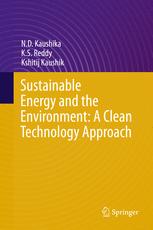

Most ebook files are in PDF format, so you can easily read them using various software such as Foxit Reader or directly on the Google Chrome browser.
Some ebook files are released by publishers in other formats such as .awz, .mobi, .epub, .fb2, etc. You may need to install specific software to read these formats on mobile/PC, such as Calibre.
Please read the tutorial at this link: https://ebookbell.com/faq
We offer FREE conversion to the popular formats you request; however, this may take some time. Therefore, right after payment, please email us, and we will try to provide the service as quickly as possible.
For some exceptional file formats or broken links (if any), please refrain from opening any disputes. Instead, email us first, and we will try to assist within a maximum of 6 hours.
EbookBell Team

4.0
96 reviewsThis book emerges from the recognition that energy, environment and ecosystems are dynamically and inextricably connected. The energy environment system must be addressed in its totality, so that we can devise sustainable solutions that incorporate both economic growth and environmental conservation. No single clean energy source will sustain long-term energy security, and fossil fuels will remain prominent in the mix of energy sources for several decades to come. Energy solutions, therefore, must employ a broad and diverse range of approaches, including cleaner fossil fuel technologies, and an affordable transition to greener power generation employing waste, water and renewable resources. Moreover, adapting to this changing global energy picture will require a transformational shift in the ways we use and deliver energy services. The authors begin with a broad introductory chapter on sustainable energy and the environment, classifying energy resources, cataloging environmental degradations, and outlining the concepts and practices of sustainability. In Chapters Two and Three, they summarize the basic constituents of the environment, the biosphere and its natural cycles, and offer a model of Earth’s planetary temperatures and the greenhouse effect. Chapters Four and Five outline conventional energy and power systems, and related environmental degradations. The next several chapters cover clean coal technologies for power generation, and discuss sustainable energy and power technologies based on both thermal and photovoltaic solar energy, along with biomass and wind. The final chapters examine in depth the management of waste and water, pollution control and energy conservation.
The book introduces a unique approach to sustainability and energy conservation which emphasizes the relationships between underlying scientific principles and practical applications employed in engineering solutions. All this is offered in a form that matches the requirements of college-level environmental science and engineering courses.